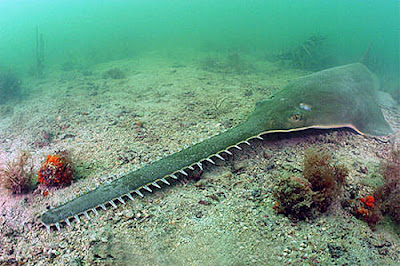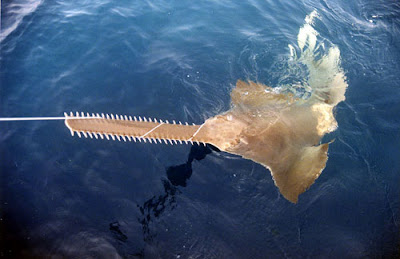Fish World | Smalltooth Sawfish | The sawfish family derives its name from its elongated, blade-like snout, studded with a number of teeth on either side. The smalltooth sawfish has smaller teeth than other member of its family. Other common names that identify this species include common sawfish, sawfish, comb shark, small-tooth common sawfish, and wide sawfish.
The smalltooth sawfish was first described by Latham (1794) as Pristis pectinatus. This name was recently changed to the currently valid Pristis pectinata (Latham 1794) due to a gender issue with the original name. The genus name Pristis is derived from the Greek word "pristis" meaning saw. Synonyms that have also appeared in the literature include Pristis serra Bloch and Schneider 1801, Pristis granulosa Bloch and Schneider 1801, Pristis acutirostris Duméril 1865, Pristis leptodon Duméril 1865, Pristis megalodon Duméril 1865, Pristis occa Duméril 1865, Pristis woermanni Fischer 1884, Pristis evermanni Fischer 1884, and Pristis anandalei Chaudhuri 1908.
The sawfish family derives its name from its elongated, blade-like snout, studded with a number of teeth on either side. The smalltooth sawfish has smaller teeth than other member of its family. Other common names that identify this species include common sawfish, sawfish, comb shark, small-tooth common sawfish, wide sawfish (English); espadachin, espadon, pejepeine, pejes sierra, pez espada, pez rastrillo, sierra (Spanish); zaagvis (Dutch); serra (Portugese); requin-scie, poisson scie (French); pristis (Greek); and kammsagefisch (German).
Smalltooth sawfish are found in the tropical and subtropical Atlantic Ocean. In the western Atlantic they have historically ranged from New York to Brazil, including the Gulf of Mexico and Caribbean Sea. They are found in the eastern Atlantic from Gibraltar to the southwest coast of Africa, and once possibly inhabited the Mediterranean Sea. Genetic research conducted by Vicente Faria has revealed that opposed to the commonly held belief of smalltooth sawfish as a circumglobal species, the species has only been observed in the Atlantic Ocean with many dwarf and green sawfish misidentified as smalltooth sawfish.
Smalltooth sawfish are found in the tropical and subtropical Atlantic Ocean. In the western Atlantic they have historically ranged from New York to Brazil, including the Gulf of Mexico and Caribbean Sea. They are found in the eastern Atlantic from Gibraltar to the southwest coast of Africa, and once possibly inhabited the Mediterranean Sea. Genetic research conducted by Vicente Faria has revealed that opposed to the commonly held belief of smalltooth sawfish as a circumglobal species, the species has only been observed in the Atlantic Ocean with many dwarf and green sawfish misidentified as smalltooth sawfish.
This sawfish primarily occurs in estuarine and coastal habitats such as bays, lagoons, and rivers. It does at times occur in deeper waters, however, and may make crossings to offshore islands. It can tolerate freshwater.
This fish is easily recognized by its flattened body and wing-like pectoral fins. The mouth is located ventrally, the eyes are positioned dorsally. The rostral saw of P. pectinata is approximately 25% of the body's total length. The saw is widest at the base, with teeth more broad than long, and spaced apart. Anteriorly, the teeth become more long than broad. Each tooth is slightly flattened dorso-ventrally creating a sharp anterior edge, while the posterior of the tooth has a groove that creates two cutting edges. The tips of the teeth are sharp, becoming blunt over time.
This fish is easily recognized by its flattened body and wing-like pectoral fins. The mouth is located ventrally, the eyes are positioned dorsally. The rostral saw of P. pectinata is approximately 25% of the body's total length. The saw is widest at the base, with teeth more broad than long, and spaced apart. Anteriorly, the teeth become more long than broad. Each tooth is slightly flattened dorso-ventrally creating a sharp anterior edge, while the posterior of the tooth has a groove that creates two cutting edges. The tips of the teeth are sharp, becoming blunt over time.
The smalltooth sawfish shares the western Atlantic and parts of the eastern Atlantic with the largetooth sawfish (P. perotteti), and can be distinguished from it based on a few morphological characteristics. The first dorsal fin of P. pectinata originates at the same place dorsally as the pelvic fins do ventrally, while in P. perotteti the first dorsal originates anterior to the pelvic fins. The pectoral fins of P. pectinata are smaller than those of P. perotteti. The upper and lower lobes of P. pectinata's caudal fins are less prominent than those of P. perotteti. Finally, the saw of P. pectinata contains 25-32 pairs of rostral teeth while P. perotteti has a maximum of 20 teeth, which are larger in size.
Ten to twelve rows of teeth are maintained in both jaws of the smalltooth sawfish. The upper and lower jaws have approximately 88-128 and 84-176 teeth respectively. The teeth are rounded anteriorly and have a blunt cutting posterior edge.
Numerous dermal denticles vary in size and shape. Dorsally, the denticles are blunt and ovate in shape with low pedicels, which give a roughness to the skin. The smallest denticles tend to be found toward the outer margins of the fins and on the head, just anterior to the eyes. Ventrally, the denticles are blunt, varying from round to oval to rounded subpolygonal, and lack pedicels. The fact that they lack pedicels makes the ventral side smoother to the touch than the dorsal side. Denticles are so prolific ventrally that the skin is barely visible.
Ten to twelve rows of teeth are maintained in both jaws of the smalltooth sawfish. The upper and lower jaws have approximately 88-128 and 84-176 teeth respectively. The teeth are rounded anteriorly and have a blunt cutting posterior edge.
Numerous dermal denticles vary in size and shape. Dorsally, the denticles are blunt and ovate in shape with low pedicels, which give a roughness to the skin. The smallest denticles tend to be found toward the outer margins of the fins and on the head, just anterior to the eyes. Ventrally, the denticles are blunt, varying from round to oval to rounded subpolygonal, and lack pedicels. The fact that they lack pedicels makes the ventral side smoother to the touch than the dorsal side. Denticles are so prolific ventrally that the skin is barely visible.
The saws of newborns are completely void of denticles. However, by the time the animal reaches 4.5 feet (1.4 m), the saw is completely covered. Denticles on the midzone of the saw are similar in size to those located ventrally, but become larger toward the saw edges.
Sawfishes are ovoviviparous, producing embryos that mature internally and are nourished by a yolk sac. Gestation is believed to last a year, with 15-20 pups born per litter. Increased catch records of gravid females and juveniles in late spring and early autumn suggests that P. pectinata gives birth during the warmer summer months. Over parts of their range where the water is warm throughout the year, it has been speculated that this fish has a continual reproductive cycle. Females in southern Africa have been recorded moving into the safety of estuaries to give birth. The saws of the pups are fully developed and sheathed upon birth, but are malleable to prevent injury to the mother while passing through the cloaca.
Sawfishes are ovoviviparous, producing embryos that mature internally and are nourished by a yolk sac. Gestation is believed to last a year, with 15-20 pups born per litter. Increased catch records of gravid females and juveniles in late spring and early autumn suggests that P. pectinata gives birth during the warmer summer months. Over parts of their range where the water is warm throughout the year, it has been speculated that this fish has a continual reproductive cycle. Females in southern Africa have been recorded moving into the safety of estuaries to give birth. The saws of the pups are fully developed and sheathed upon birth, but are malleable to prevent injury to the mother while passing through the cloaca.















